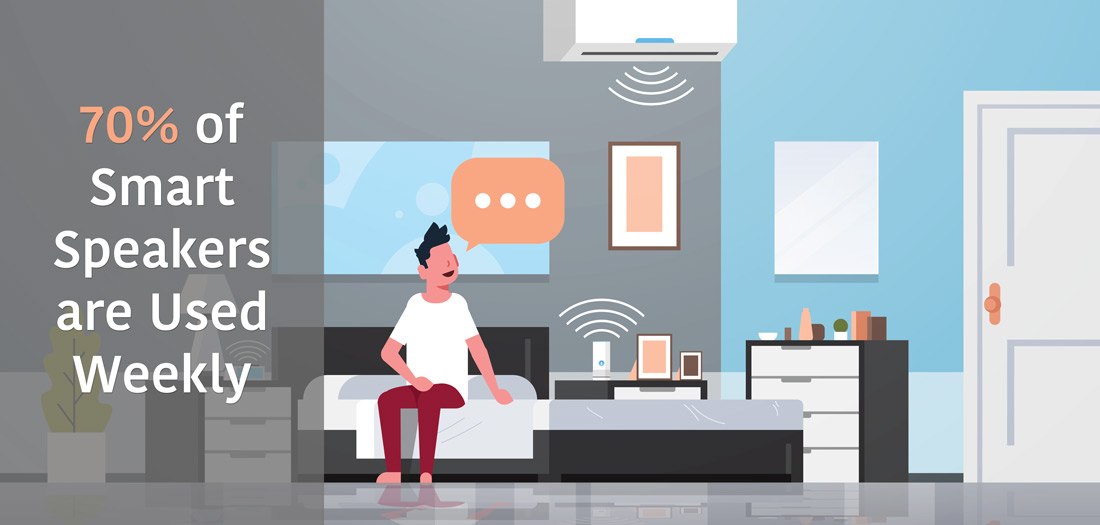Published: 09/07/2019
Introduced in November of 2014, the first smart speaker to hit the market was the Amazon Echo, which was available to Prime members only. Amazon officially launched the Echo on June 23rd of 2015. Soon to follow came the Amazon Echo Dot in March of 2016 and Google Home on November 4th of 2016. To date, smart speaker popularity has taken off and a variety of manufacturers have begun producing their own models. Though many models many incorporate the same voice assistant technology. Mainly Amazon Alexa, Google Assistant, Siri, Microsoft Cortana, and Spark Assistant. While originally smart speakers were available only in the US, today a smart speaker can be purchased in most countries.
Smart Speaker Timeline Infographic »
How Many People Own A Smart Speaker? Which Speakers Most Popular?
United States
The popularity of smart home speakers is continuing to grow, with over 25% of U.S. adults owning one. This figure breaks down to 66.4 million users in the U.S. alone. And, according to Global Market Insights, the smart speaker market size is projected to reach $30 billion by 2024.
Around the globe, smart speaker sales are increasing as well, though some markets are slower than others.
I’m sure it won’t come as a surprise to learn that Amazon’s Echo continues to dominate the smart speaker market. In fact, according to a report by voicebot.ai and Voicify, comparing January of 2018 to 2019 sales, the Amazon Echo maintained a 61% market share with Google Home owning a 24% share. The remaining 15% of the market space was primarily divided up between Apple HomePod and SonosOne. However, when comparing these figures, know that Apple HomePod wasn’t launched in the U.S. till February 2018, so it won’t be reflected in the January 2018 totals. And to be fair, the SonosOne has built-in Amazon Alexa so their slight loss of market share so the numbers might not be as bad as it seems.
Other notable brands competing for market share include Bose, JBL, Polk, NetGear, Ultimate Ears, Vizio, and Sony. While it’s nice to see other well-known brands enter the smart speaker market, they have a lot of catching up to do to compete with Google and Amazon.
Smart Speaker Market Share in The U.S.
January 2019
January 2018
United Kingdom
Similar to the U.S. market, in the United Kingdom Amazon Echo sales are at the forefront owning 68% of the market space in 2018. Amazon Echo sales were followed by Google Home which accounted for 29% of sales. Overall, smart speaker sales doubled in the U.K. from 2017 reaching 9.5 million smart speaker users. This number is expected to rise to 12.6 million users in 2019 with Amazon sales continuing to dominate. According to Jaimie Chung, eMarketer forecasting analyst, these numbers are a reflection of:
“Early adopters tend to be open-minded about brands, usually picking whichever speaker is first available in stores. Amazon got to the UK before Google, and usage reflects this…Market shares will continue to shift as users learn the nuances of the different voice assistants.”
China
According to a report published by Canalysis, smart speaker sales in China for the first time overtook U.S. sales. In Q1 of 2019, 10.6 million units were sold fueled by festive sales. China alone now accounts for 51% of the global market. Followed by 24% from the U.S., 5% from the U.K., and 20% from the remainder of the world.
While the Chinese market is highly competitive, Google and Amazon have no presence there. The market is led by Alibaba with 41.2%, Baidu with 32.4%, and Xiaomi with 26.5% of the market share in Q4 of 2018. The biggest rise was from Alibaba, gaining 4.48% of the market space over Q3.
Smart Speaker Market share in china
Q4 2018
Q3 2018
Overall, Canalysis estimates the smart speaker market in China will rise 166% in 2019 resulting in 59.9 million sales.
India
In India, the Amazon Echo was at the forefront of smart speaker sales with over a 59% share in 2018. Following its launch in Q2 of 2018, Google Home closed the year with a 39% share. Overall, 753,0000 units were sold throughout India in 2018.
Australia
In Australia, smart speaker ownership surpassed U.S. sales in 2018, with 29.3% (5.7 million) of adults as of January 2019 now owning a smart speaker. Though, unlike the U.S., Google Home accounted for 68% of overall sales dominating over the Amazon Echo which only made up 14% of the market.
What Are Smart Speakers Used For?
The question is, with such a rise in smart speaker sales, what are smart speakers used for?
According to a survey conducted by voicebot.ai, 70% of smart speakers are used weekly and 86% are used at least once a month. Where owners primarily use their smart speakers to stream music, ask questions, check the weather, set a timer/alarm, and to listen to the radio. The results of this survey are shown in the chart below.
Smart Speaker Daily Use frequency (Percentage)
Other notable conclusions of the survey were how many people use smart speakers to make an online purchase. Interestingly enough, one-in-four smart speaker owners claimed to have placed an order at least one time using their smart speaker. And at least 11.5% do so monthly. Another interesting find was regarding communications. While not frequently used but a major selling point of smart speakers, communications features were reported as being used by 10% of owners daily.
What’s Next For Smart Speakers?
Overall, the smart speaker market is expected to rise from $1.57 billion (USD) in 2017 to $11.79 billion (USD) by 2023, according to Markets and Markets. A huge driving factor behind smart speaker use and ownership is the adoption of smart devices. As smart devices (smart thermostats, security systems, irrigation systems, lighting, and other devices that use an internet/network connection) become increasingly more common in homes and offices, so will smart speakers. This exponential growth, however, does introduce some concerns and limitations. The main concern regarding security and privacy.















